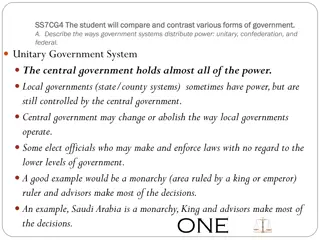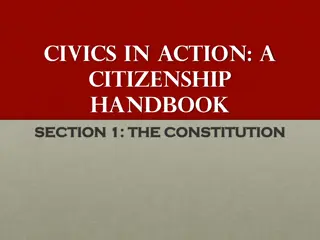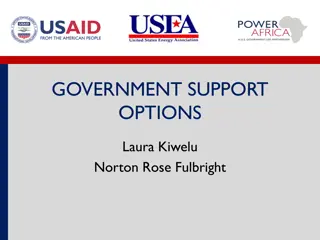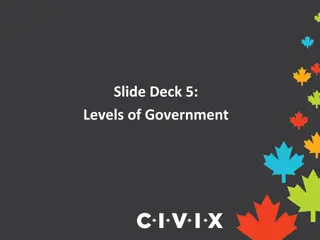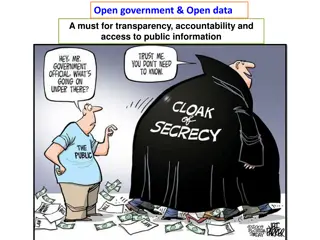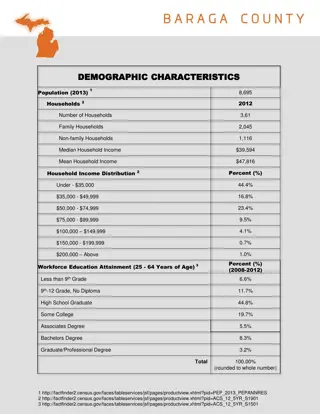Understanding the U.S. Government Structure and Processes
Explore the roles of the three branches of the U.S. government, including the legislative, executive, and judicial branches. Learn about the separation of powers, the House of Representatives, the Senate, presidential requirements, terms and limits, incumbency, law-making processes, and more. Dive into essential questions regarding congressional agendas and outside influences on legislative processes.
Download Presentation

Please find below an Image/Link to download the presentation.
The content on the website is provided AS IS for your information and personal use only. It may not be sold, licensed, or shared on other websites without obtaining consent from the author. Download presentation by click this link. If you encounter any issues during the download, it is possible that the publisher has removed the file from their server.
E N D
Presentation Transcript
UNIT 3 RULES WERE MADE TO BE BROKEN OR AT LEAST INTERPRETED GPS STANDARD 1 What does the legislative branch do?
UNIT 3 RULES WERE MADE TO BE BROKEN OR AT LEAST INTERPRETED GPS STANDARD 2 What does the executive branch do?
UNIT 3 RULES WERE MADE TO BE BROKEN OR AT LEAST INTERPRETED GPS STANDARD 3 What does the judicial branch do?
UNIT 3 RULES WERE MADE TO BE BROKEN OR AT LEAST INTERPRETED GPS STANDARD 4 What is the separation of powers in the constitution?
HOUSE OF REPS 5 How many members? 6 How many per state? 7 How old you have to be? 8 How long do you have to have been a us citizen? 9 Do you have to live in state? 10 How long is term? 11 What is term limit?
SENATE 12 How many members? 13 How many per state? 14 How old you have to be? 15 How long do you have to have been a us citizen? 16 Do you have to live in state? 17 How long is term? 18 What is term limit?
PRESIDENT 19 How old you have to be? 20 Do you have to be born in US? 21 How long do you have to have been a us citizen? 22 Do you have to live in state? 23 How long is term? 24 What is term limit?
ESSENTIAL QUESTION 26 HOW DOES AN IDEA FOR A LAW BECOME A LAW?
27 WHAT IS A CONGRESSIONAL AGENDA?
ESSENTIAL QUESTION 28 What are the outside influences on members of Congress and the legislative process?
UNIT 3: RULES WERE MADE TO BE BROKEN OR AT LEAST INTERPRETED American Government Coach Vasilchek
UNIT 3 RULES WERE MADE TO BE BROKEN OR AT LEAST INTERPRETED GPS STANDARD SSCG 4-The student will demonstrate knowledge of the organization and powers of the national government a. Describe the structure and powers of the legislative, executive and judicial branches.
Judge whether laws are constitutional and whether they were broken
UNIT 3 RULES WERE MADE TO BE BROKEN OR AT LEAST INTERPRETED GPS STANDARD SSCG9- The student will explain the differences between the House of Representatives and the Senate, with the emphasis on terms of office, powers, organization, leadership, and representation of each house.
THREE POWERS OF THE HOUSE OF REPRESENTATIVES Initiate revenue (tax) bills Choose the President when the electoral college is deadlocked (Election of 1800) Choose whether to Impeach someone (choose whether to take it to trial or not
THREE POWERS OF THE SENATE Treaty ratification Confirmation or Denial of judicial and executive appointments Impeachment Trials
CONSTITUTIONAL CREATION When the constitution was created: The small states wanted equal representation They wanted this so that they had an equal say in the new government The large states wanted proportional representation They wanted this so that the states with the larger population would have more representatives in the new government The great compromise gave them both The senate= equal representation= small states wants The house of representatives= proportional representation=large state wants
HOW OLD YOU GOTS TO BE HOUSE OF REPRESENTATIVES=25 years old SENATE= 30 years old PRESIDENT= 35 years old EMPEROR= 50 years old
TERM PERIODS/LIMITS Term Periods The House of Reps= 2 years The Senate= 6 years The President= 4 years Term Limits The House of Reps= no term limit The Senate= no term limit The President= 2 term limit or 10 years total
WHAT IS AN INCUMBENT? Incumbent: the current officeholder Incumbents have a very high re-election rate (80-90%) Yet the public does not hold Congress in very high esteem Voters seem only to be satisfied with their own representatives SO WHY ARE INCUMBENTS RE-ELECTED SO OFTEN?????? Because people are familiar and comfortable with the incumbent.
HOW ISSUES GET ON THE CONGRESSIONAL AGENDA Agenda: the schedule of all the issues the Congress is considering Many issues have been on the agenda a long time Other issues emerge suddenly, often due to technological change
HOW ISSUES GET ON THE CONGRESSIONAL AGENDA Issues may reach the agenda in many ways A highly visible event (like 9/11) draws our attention to a problem Presidential support Congressional party leaders and committee chairs Interest group efforts
UNIT 3 RULES WERE MADE TO BE BROKEN OR AT LEAST INTERPRETED GPS STANDARD SSCG 10- The student will describe the legislative process including the roles played by committees and leadership. a. Explain the steps in the legislative process b. Explain the function of various leadership positions within the legislature
HOW A BILL BECOMES A LAW VIDEO LINK: https://www.youtube.com/watch?v=tyeJ55o3El0
PRESIDENTIAL VETO A Presidential Veto is where the president votes no on a law which was passed through the House of Reps and the Senate A Presidential Veto can be overridden by a 2/3 vote in the House of Reps and the Senate
THE DANCE OF LEGISLATION: AN OVERVIEW President s Action Sign Veto Neither sign nor veto within 10 days Bill becomes Law Neither sign nor veto within 10 days but Congress adjourns (Pocket Veto) Content of bill can be changed at any time in legislative process
COMMITTEES: Committees develop and use expertise in specific areas Committee Types Standing: permanent committee that oversees bills dealing with certain kinds of issues Joint: committee of the House and Senate that usually acts as a study group and reports findings back to each Select (or Special): temporary committee formed to study one specific issue and report its findings to the Senate or House Conference: temporary joint committee set up when the House and the Senate have passed different versions of the same bill
COMMITTEES: THE WORKHORSES OF CONGRESS Congressional Expertise and Seniority- Because of more experience and expertise, people tend to listen to senior congress persons. Influence on committees grows formally with seniority Influence on committees grows informally with increased expertise Senior member of the majority party usually becomes the committee chair
COMMITTEES: THE WORKHORSES OF CONGRESS Public policy decision-making takes place in committees Committees hold hearings: sessions in which committee members listen to testimony on issues related to a bill Markup Sessions: the meetings at which committees debate and amend legislation
COMMITTEES: THE WORKHORSES OF CONGRESS Oversight: the process of reviewing the operations of an agency to determine whether it is carrying out policies as Congress intended Oversight has become more difficult Congress has added resources to perform the oversight function Majoritarian and Pluralist Views of Committees
THE LEGISLATIVE ENVIRONMENT The President- due to the president s popularity, he or she puts a lot of pressure on the legislature. Presidents capitalize on nationwide popular election Public expects president to be legislator-in-chief Hundreds of legislative liaison personnel work for executive branch
THE LEGISLATIVE ENVIRONMENT Constituents- put pressure on the legislature because the legislature lives in their district with these people. Constituents: people who live and work in a government official s district
THE DILEMMA OF REPRESENTATION Trustees or Delegates? Trustee:representative who is obligated to consider the views of constituents but is not obligated to vote according to those views if he or she believes they are misguided Delegate:a legislator whose primary responsibility is to represent the majority view of his or her constituents, regardless of his or her own view
INTEREST GROUPS IN AMERICA Interest Group: a group of people with common goals who organize to influence government Interest Group Roles 1. Representation 2. Participation 3. Education 4. Agenda Building 5. Program Monitoring
INTEREST GROUP RESOURCES Political Action Committees (PACs):an organization that pools contributions from group members and donates those funds to candidates for office
INTEREST GROUPS AND BIAS Citizen Groups: lobbying organizations built around policy concerns unrelated to members vocational interests citizen groups: poverty, environmental protection, consumer protection, family values, good government, equality for various groups
GPS STANDARD SSCG11 The student will describe the influence of lobbyists (business, labor, professional organizations) and special interest groups on the legislative process. a. Explain the function of lobbyists. b. Describe the laws and rules that govern lobbyists. c. Explain the function of special interest groups.
INTEREST GROUP RESOURCES Lobbyists- people who interact with policymakers/legislators with the goal of informing and pushing their organizations agenda into congress. Can be either full-time employees of the organization or hired from law firms or public relations firms Must register with House and Senate; limits on gifts; cannot lobby for a government agency for which they were formerly employed for two years ( revolving door ) Lobbyists can be fundraisers for candidates Typical interaction between lobbyists and
LOBBYING TACTICS Direct Lobbying:attempts to influence a legislator s vote through personal contact Grassroots Lobbying: lobbying activities performed by rank-and- file interest group members and would-be members Information Campaign: are organized efforts to gain public backing by bringing the group s views to public attention High-Tech Lobbying:using e-mail, polling and the World Wide Web to expand an organization s reach Coalition Building: the banding together of several interest groups for the purpose of lobbying
UNIT 3 RULES WERE MADE TO BE BROKEN OR AT LEAST INTERPRETED GPS STANDARD SSCG 15- The student will explain the functions of the departments and agencies of the federal bureaucracy a. Compare and contrast the organization and responsibilities of independent regulatory agencies, government corporations, and executive agencies. b. Explain the functions of the Cabinet.
GOVERNMENT CORPORATIONS/INDEPENDENT REGULATORY AGENCIES A GOVERNMENT CORPORATION IS A CORPORATION FULLY OR PARTIALLY OWNED BY THE GOVERNMENT. GOVERNMENT CORPORTATIONS-USPS,FDIC INDEPENDENT REGULATORY AGENCIES Independent agencies of the United States federal government are those agencies that exist outside of the federal executive departments More specifically, the term may be used to describe agencies that, while constitutionally part of the executive branch, are independent of presidential control, usually because the president's power to dismiss the agency head or a member is limited. IRA EXAMPLES: CIA, FBI, DEA
THE EXECUTIVE BRANCH ESTABLISHMENT The Cabinet Cabinet:a group of presidential advisers; the heads of the executive departments and a small number of other key officials
THE EXECUTIVE BRANCH ESTABLISHMENT The Cabinet includes the Vice President and the heads of 15 executive departments the Secretaries of Agriculture, Commerce, Defense, Education, Energy, Health and Human Services, Homeland Security, Housing and Urban Development, Interior, Labor, State,Transportation, Treasury, and Veterans Affairs, as well as the Attorney General.










